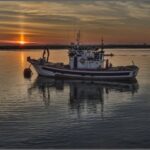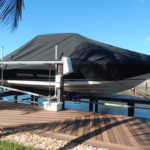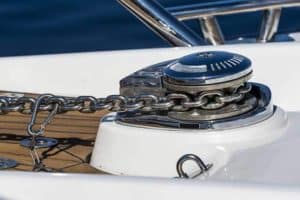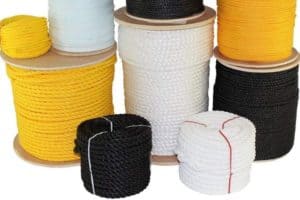The anchor is one of the most important parts of a boat. But not all anchors are the same. In this article, I’ll list 7 of the most common boat anchor types so that you know what anchor is best for your boat.
The different boat anchor types are as follows:
| Boat Anchor Type: | Popular Amazon Examples: (click the link or image below to view the deal on Amazon) | |
| Claw/Bruce Anchor | Lewmar Claw Anchor |  |
| Plow Style or CQR/Plow & Delta/Wing Anchor | Lewmar Galvanized Delta Anchor |  |
| Danforth/Fluke or Lightweight Anchor | Fortress Marine Anchors – Fortress FX-16 |  |
| Rocna Anchor | Rocna Galvanized Anchor |  |
| Grapnel Anchor | Extreme Max BoatTector Folding/Grapnel Anchor |  |
| Mushroom Anchor | Seachoice Mushroom Anchor |  |
| Box Anchor | Slide Anchor – Box Anchor for Offshore Boat Anchoring |  |
The type of boat anchor you use must be suitable for your boat’s type, size, underwater conditions, and the weather that you usually encounter. Also, the weight of the anchor is just as, if not more important, than the type of anchor.
Read on to learn more about the different boat anchor types (including the different pictures of boat anchors), so you can choose the right one for your boat.
Boat Anchor Types
Boat anchors are made of different materials, styles, designs, sizes, and weights. With so many anchors available in the market, choosing the one that will exactly fit your needs can be overwhelming. I’ve included the best boat anchors on Amazon for each anchor type.
1. Claw/Bruce Anchor
The first on our list of different types of boat anchors is the Claw/Bruce anchor. This type of anchor has the shape of a claw, which allows it to perform a 360° turn without breaking from its moors. It is very popular among recreational boaters worldwide.
This anchor’s popularity grew because no matter how it is dropped or turned around, it tends to quickly right itself. The Bruce Anchor Group developed this type of anchor in the 1970s. However, the company’s patent for this design expired in the early 2000s. From then on, other companies have copied it.
One example of this type of anchor is the Lewmar Claw Anchor. It is made of tough, high-grade steel and is suited to various kinds of sea beds. The anchor is bow roller storable as well.
Click here to see it on Amazon.
This type of boat anchor can be used for most types of sea bottoms, including coral, rock, sand, and mud. But it is difficult for claw anchors to penetrate more solid surfaces like clay and sea bottoms with heavy grasses. If you like this type, choose an anchor with a three-claw design. Compared to other anchors, it sets itself more easily.
2. Plow Style Anchor or CQR/Plow & Delta/Wing
Next on our list of different types of boat anchors is the Plow Style anchor. This anchor style offers good holding power over many different types of sea bottoms, which is why it’s a popular choice among boaters. A plow style anchor either has a pivoting (CQR) or a fixed (Delta style) shank.
One of its plows lands on its side when dropped at the seafloor. When it is pulled, the plow buries itself. The shape of the anchor enables it to reset easily if the tide or wind changes the position of the boat.
An example of this type of anchor is the Lewmar Galvanized Delta Anchor. This anchor is one of the best boat anchors around. It is made of high-grade manganese steel. It is self-launching, and it comes in various weights.
Click here to see it on Amazon.
Another example of a plow style anchor is the Mophorn Delta Style Boat Anchor. This stainless steel anchor is made of high-grade and corrosion-resistant 316 stainless steel. It can be deployed from 28 to 42 feet.
Click here to see it on Amazon.
The main difference between the CQR and the Delta is their design. CQR anchors have a hinged style, while Delta has a one-piece style. The design of CQR dates back to the 1930s.
Both of these styles perform well in bottoms with grass and weeds, including sand. However, they struggle with rocks and don’t do well on soft bottoms.
3. Danforth/Fluke or Lightweight Anchor
This type of anchor has two elongated pivoting “flukes.” Another fluke-styled anchor is called the Fortress. It is different from the Danforth as it is typically made of high-strength and lightweight aluminum instead of cast galvanized metal.
Since they are lightweight anchors, they are typically adapted to small recreational boats. They are very effective in hard sandy and muddy bottoms. Their lightweight nature also makes them the ideal choice for secondary anchors.
An example of this Danforth style of boat anchor is the Fortress Marine Anchors – Fortress FX-16. This anchor is ideal for boats measuring 33 to 38 feet long. It is made of hardened, high-tech, and rustproof aluminum-magnesium alloy.
Click here to see it on Amazon.
This anchor has a superior holding power at a fraction of the weight. Moreover, it has gathered the highest rating of all boat anchors in more than 20 independent tests around the world. These anchors are used by the U.S. Coast Guard and the U.S. Navy as well.
If you have a smaller boat, consider the Fortress FX-7 manufactured by the same company.
Click here to see it on Amazon.
This fluke style anchor is ideal for boats measuring 16 to 27 feet long. It is also made of hardened, high-tech, rustproof aluminum-magnesium alloy and is tested by the U.S. Coast Guard and Navy.
4. Rocna Anchor
Another common anchor on our list of different types of boat anchor is the Rocna anchor. Peter Smith, a New Zealand cruiser, developed the Rocna anchor. He developed this modification after more than 100,000 nautical miles of ocean cruises. Smith wanted to build a better anchor than what was available. After years of tests and tweaks, he finally launched this type of boat anchor in 2004. Now, it is regarded as the best multi-purpose boat anchor in the world.
The roll bar integration design makes the Rocna one of the best boat anchors. This roll bar helps to turn over the anchor so that it can position itself into the correct setting angle when it hits the seafloor.
This anchor also has setting skids, which help keep it in the correct position while sitting on the sea bed. It is equipped with a concave fluke that can cut into the seafloor; thus, burying itself efficiently and fast.
The Rocna Galvanized Anchor is a good example of this type of boat anchor.
Click here to see it on Amazon.
It is made of galvanized steel and the best multi-purpose anchor that sets in all types of sea floors. This anchor type is recommended for boats of all sizes, including small runabouts and superyachts.
5. Grapnel Anchor
If you own a kayak, a canoe, or a dinghy, you should use a grapnel type anchor. These anchors are designed just for small boats. They don’t have much-holding power, so they can only be used in small watercraft.
These anchor types are also very popular among fishers with small boats. They are small and can be folded, so they only require minimal storage space. Grapnel anchors are mostly used by those involved in the recovery of bottom items and wreck reef anchoring.
A good example of this type of anchor is the Extreme Max 3006.6678 BoatTector Folding/Grapnel Anchor. This stainless steel anchor is made of stainless steel and weighs 5.5 pounds.
Click here to see it on Amazon.
It is one of the best boat anchors for inflatable boats, jon boats, canoes, dinghies, and PWCs. They are best used in rocky and hard bottoms and bottoms with weeds and grasses. It is recommended to use only for short holds in low or no current.
6. Mushroom Anchor
This anchor got its name from its basic shape, which is similar to that of a mushroom. Mushroom-type anchors are primarily used for moorings. They work best in soft bottoms where their mushroom shape creates suction.
Mushroom anchors are suitable for small boats, but some of the bigger anchors are used for permanent moorings for buoys. The holding power of these anchors comes from the silt that builds up over them. When the silt has buried the anchor, tremendous holding power is created. They are ideal for sea or lake bottoms with unpacked sand, soft mud, and silt.
The Seachoice Mushroom Anchor is a good example of a mushroom boat anchor system. This anchor is made of cast iron that is aluminum-painted and coated with vinyl. It is ideal for small boats and mooring buoys.
Click here to see it on Amazon.
The vinyl coating protects the hull of the boat against damage when the anchor is deployed. This anchor can be used for small boats with lengths up to 24 feet. It is a very durable boat anchor that weighs 20 pounds.
7. Box Anchor
The most attractive feature of the box anchor is its ability to set immediately into the sea or lake bottom without requiring additional power from the boat. Thus, you don’t need to power down the boat to ensure its stability.
This type of boat anchor system is best for boats up to a maximum length of 70 feet. It has the following features:
- Sets into any kind of condition at the bottom
- Can reset itself if there are changes in the wind, current, or weather
- It only requires half the length of the line as that of traditional anchors
- Folds flat in storage
A good example of this anchor type is the Slide Anchor – Box Anchor for Offshore Boat Anchoring. It is a small box anchor ideal for boats measuring 18 feet to 30 feet long and for cabin cruisers with a maximum length of 24 feet.
Click here to see it on Amazon.
This anchor will easily set into the bottom regardless of the conditions. It does not require any power from the boat. Just turn off the engine, toss the anchor overboard, and it will settle within 1 foot where it landed. The design of this anchor also allows for more control in the placement of the boat.
Generic Vs. Trademarked Anchor Names
You might be confused about the name of the anchors. Many boat anchors are known by brand or trademark names rather than their generic names.
For instance, Xerox is a brand name of a photocopier. However, when consumers talk about photocopying a document, most of them will say they will make a ‘xerox’ copy of the document. The same goes for boat anchors.
The following table will show the generic and trademark names of boat anchors.
| Generic Name | Trademarked Name |
| Claw | Bruce |
| Plow/Hinged Plow | CQR |
| Fluke | Danforth |
| Wing | Delta |
Tips for Choosing the Right Anchor for Your Boat
Here are four quick tips on how you can choose the right anchor for your boat.

1. Use Two Anchors with Different Styles
For the most effective anchoring security, you should use two anchors with differing styles. The type of sea bottom will dictate the type of anchor you need to use. Also, there will be times that you may need to use an anchor on the bow and another anchor on the stern.
2. Consider Weather and Water Conditions
Choose the types of anchor suited to the weather, bottom characteristics, and water current conditions that you always encounter in your boating trips.
3. Choose the Right Size
The size of the anchor should be appropriate for the size of your boat.
4. Choose the Right Weight
Using the right weight of the anchor will optimize its holding power. To give you an idea, an anchor weighing only 5 pounds can hold weight up to 1,000 pounds.
Conclusion – Boat Anchor Types
The different boat anchor types are as follows:
- Claw/Bruce
- Plow Style or CQR/Plow & Delta/Wing
- Danforth/Fluke or Lightweight
- Rocna
- Grapnel
- Mushroom
- Box
There are different types of underwater or sea bottom conditions that can pose challenges to all boat anchor types. Remember, the anchor’s weight is more important than its particular design when it comes to its penetration and holding power. With the above guide, you should have a better idea of the right anchor type for your boat.
Related reading:
Jon Boat to Bass Boat Conversion – 6 Steps
Jon Boat Weight Capacity (Plus Several Examples)











![Boat Floor Replacement Plywood [Best Options] boat floor replacement plywood](https://boatinggeeks.com/wp-content/uploads/2021/07/boat-floor-replacement-plywood-150x150.jpg)


